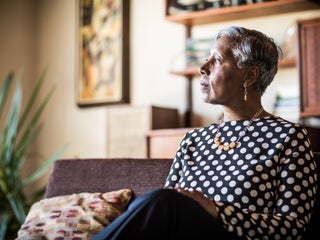Summary
Investing isn’t one-size-fits-all. Age, risk tolerance and individual goals all come together to shape a portfolio. Though it may not seem obvious, whether you’re investing as a woman or a man also comes into play. “When it comes to investing and building a financial plan, women have very specific needs…
The content on this page is accurate as of the posting date; however, some of our partner offers may have expired. Please review our list of best credit cards, or use our CardMatch™ tool to find cards matched to your needs.
Investing isn’t one-size-fits-all. Age, risk tolerance and individual goals all come together to shape a portfolio.
Though it may not seem obvious, whether you’re investing as a woman or a man also comes into play.
“When it comes to investing and building a financial plan, women have very specific needs and desire an approach that more directly aligns with their lifestyle demands, personal values and financial priorities,” says Brittan Leiser, a financial advisor and founder of SavviHer.
Those needs and desires have to counterbalance the unique challenges women often face when paving a path to wealth through investing. Those challenges include the gender pay gap, longer life expectancies and the potential for reduced earning power among women who take time away from the workforce to care for children and/or aging parents.
The result is a rethinking of the traditional investing rules.
“Though female investors desire favorable market returns and a well-balanced portfolio similar to their male counterparts, they’re actively redefining what it means to achieve financial success for them,” says Leiser.
Use savings to build a foundation for investing
While many women may be focused on the long term for investing, it’s important not to overlook short term financial needs.
Stacy J. Miller, partner, vice president and wealth advisor at Bright Investments in Auburn, Alabama, says emergency savings should be a number one priority for women.
“You should have three to six months of expenses in savings or a cash equivalent that’s available for a variety of expenses and unexpected events, such as illness, job loss or divorce,” says Miller.
Putting an emphasis on saving as a bridge step to investing is important since women typically have less in savings compared to men.
A 2018 Wealthsimple study found that men outpaced women when it came to saving, with an average balance of $49,000 versus $31,000. Women also had less in investments, averaging $36,000 compared to nearly $61,000 for men.
In terms of how that translates to a larger wealth gap over time, women who don’t focus on saving as a precursor to investing may be at a significant disadvantage. The Wealthsimple study projected that assuming a 5% rate of return over time, women stood to lose out on $106,000 in growth from compounding interest simply by having less money invested.
Once you have your short-term emergency money in place, you can move on to funding intermediate savings goals. For example, you may be saving for a vacation fund or home improvements. From there, you can begin maximizing your opportunities to invest elsewhere.
The first place women can look to is their employer’s retirement plan – if one is available. At the very least, the experts agree that it’s important to save enough to qualify for the full company matching contribution if one is offered.
Other ways to save and invest include individual retirement accounts, Health Savings accounts and taxable brokerage accounts. Miller says women are best served by leveraging tax-advantaged accounts first before moving onto taxable accounts, which don’t offer the benefit of allowing you to defer taxes on investment gains. Together, she says, these accounts can help women to grow their portfolio more quickly.
Get the right perspective on risk
A common stereotype surrounding women investors is that compared to men, they’re less likely to be risk-takers. It’s a misconception that many investors – male and female alike – have accepted as fact.
According to a 2018 Stash Invest survey, nearly 90% of women who used the platform identified themselves as having a low or medium risk tolerance, versus 75% of men. In other words, these women perceived themselves as less willing to make riskier investments.
In reality, however, roughly 50% of women who invest on the platform include higher-risk investments in their portfolios. The proportion of women taking on more risk was virtually the same as men who invested through the platform.
“Many stereotypes still persist about women and money today, which is likely due to the fact that women have been left out of the financial services industry for so long or told that money is a ‘man’s world’”, says Dale Sperling, CMO at Stash.
What’s exciting, he says, is that with the same investment tools and education women act nearly identical to men when it comes to risk. The data poses a direct challenge to the outdated notion that women are more conservative than men by nature.
Women investors may need to reexamine how they gauge their own risk tolerance and whether that assessment is accurate. Diane Bourdo, president of The Humphreys Group, an all-women owned and operated wealth management firm in San Francisco, says what’s most important for women is to take a risk that’s appropriate for their situation.
“Be risk-smart – think about how much risk you’re able to take on, given your resources, expertise and plan, versus how emotionally comfortable you are with taking investment risk,” says Bourdo. “Remember that diversification is your friend – you can reduce risk by diversifying across types of investments, investing consistently over time and maintain a long-term investment horizon.”
Leveraging compounding returns consistently is key
Though the gender pay gap is closing slowly, the fact remains that women under-earn compared to men. According to the American Association of University Women, women earn 82% of what men earn on the dollar.
When women earn less, that can have a direct impact on their ability to invest and grow wealth.
“The wage gap becomes a problem for women starting off because compounding over time is one of the most influential factors in investment outcomes,” says Aliya Riddle, a chartered financial analyst and associate investment advisor at Cincinnati-based Bartlett Wealth Management.
Compounding interest, or interest earned on your interest, is one of the simplest and most powerful tools available to investors. The more money you can invest, the more you can take advantage of compounding.
Longevity and the fact that many women take time away from work to act as caregivers can add to the difficulty presented by the gender pay gap.
According to data from The World Bank, women in the U.S. typically outlive men by five years, reaching an average life span of 81.1 years. The Family Caregiver Alliance estimates that as many as 75% of caregivers are women.
Living longer, working less and earning less can deliver a triple blow to women’s investing plans. They may have less money to invest with and that money may need to last longer and stretch further.
Riddle says women can compensate for these challenges by making investing a regular habit and not delaying their efforts.
“Even consistently investing what seems like an inconsequential amount early on will beat out trying to play catch up down the road,” she says. “If a woman waits too long to begin investing, they will find it extremely difficult to dig out of that hole later.”
Investing as a woman starts with building on the basics
Because women do face certain challenges that men may not, it could be argued that an entirely new approach to investing is needed. But really, it comes down to understanding the fundamentals and following basic best practices, says Bourdo.
That includes becoming familiar with how market cycles move and what particular investments are designed to do.
A female investor who’s focused on the short-term, for example, may be better served by investing in growth stocks. A woman who’s looking ahead to retirement, on the other hand, may lean toward stocks or other investments that generate dividend income.
Bourdo says women also need to be aware of how external factors, such as market volatility and inflation risk, might affect how they choose to allocate the assets in their portfolio. Sticking with the traditional 60-40 split between stocks and bonds, for instance, is a simplified approach but it may not serve a woman investor with a higher capacity for taking risks.
Understanding volatility is particularly important for avoiding emotional decision-making that could sidetrack your portfolio. Fortunately, this is one investing area where women tend to surpass men.
In the Stash Invest survey, men were 87% more likely than women to sell on days when the stock market experienced turbulence. While women investors played it cool during periods of stock uncertainty, men were more likely to lock in losses by panic-selling.
That kind of patience can pay off, says Riddle. “Also, by focusing on outcomes instead of performance, women are more likely to reach their investment goals.”
Don’t underestimate educating yourself
Education may represent the final piece of the puzzle for women who need or want to build their confidence as they build a portfolio. Merrill Lynch’s Women & Financial Wellness Study found that 52% of women said they felt confident about investing, compared to 68% of men.
Leiser says women can own their financial health by working with a professional advisor who’s well-versed in the various challenges women face, such as the gender pay gap and a potentially longer life span. When vetting financial advisors, it’s important to ask the right questions.
Before choosing an advisor, get to know:
- What fees they charge and how they’re paid
- Their particular investment style or strategy
- How often they work with women clients with a financial background similar to yours
- Whether they’re a fiduciary, which means they are ethically bound to act in your best interest
- How often they communicate with clients and their preferred methods for communicating
Women can also invest their time in expanding their investment knowledge by reading investing books, listening to podcasts or taking advantage of online learning tools. The most important rule of thumb to remember is to simply get started with investing if you haven’t already.
“The best time to start investing and saving for your future is yesterday,” says Sperling. “The second-best time is today.”
Putting small amounts away now can pay dividends toward your future, he says.
Editorial Disclaimer
The editorial content on this page is based solely on the objective assessment of our writers and is not driven by advertising dollars. It has not been provided or commissioned by the credit card issuers. However, we may receive compensation when you click on links to products from our partners.



